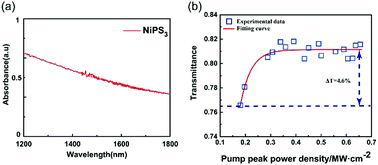NiPS3 nanosheets for passive pulse generation in an Er-doped fiber laser†
Abstract
With the rapidly increasing demands of industrial material processing, biomedical sensing, light detection, and high-speed communication, various novel two-dimensional (2D) materials have been synthesized and employed in ultrafast fiber laser generation due to their advantages of easy processing characteristics, desirable structures and excellent nonlinear optical properties. However, finding an efficient 2D material-based saturable absorber (SA) with the capacity of both high stability and excellent working property performance remains a challenge. Herein, high-quality NiPS3 crystals, from the metal phosphorus trichalcogenide (MPT3) family, were synthesized by a modified chemical vapor transport (CVT) method and a few-layer NiPS3 nanosheet SA was easily obtained using a direct liquid-phase exfoliation method. Different from other 2D materials, ultrathin NiPS3 nanosheets display a good stability. Moreover, a passively Q-switched operation and dual-wavelength mode-locked pulse output were proposed based on a NiPS3-SA erbium-doped fiber (EDF) laser. In the passively Q-switched operation, the maximum peak power was 6.40 mW with a maximum pulse energy of 29.66 nJ. It is also worth noting that dual-wavelength pulse output was achieved in passively mode-locked pulse generation. These results not only supply other choices of SAs for pulse generation, but also provide guidance to extend other possible applications of the MPT3 family for nonlinear optics.



 Please wait while we load your content...
Please wait while we load your content...